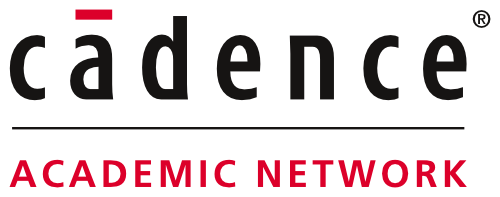BME - Biomedical Engineering Laboratory
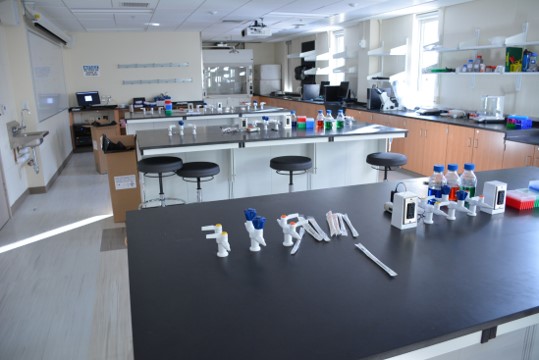
Votey 225 and 225A - 885 sq. ft.
Responsible faculty members: Amber Doiron and Juan Jose Uriarte
Courses that use this laboratory:
- BME081 - Biomedical Lab I
- BME181 - Biomedical Lab II
The biomedical engineering laboratory space is used primarily by biomedical engineering students for courses requiring ‘wet lab’ facilities. Students have access to the necessary tools and equipment for cell culture work, practicing aseptic technique and proper chemical hygiene. The lab is equipped with two large white boards and a projection system. Teaching equipment includes two biosafety cabinets, centrifuge, carbon dioxide and ambient incubators, flammables refrigerator/freezer, optical microscopes, automatic cell counter, force plates, laboratory microwave, analytical balances, sonicating and normal water baths, vortexes, single and multi-channel pipetors and a chemical fume hood. Services include vacuum, compressed air, and natural gas. The lab is equipped with an emergency shower and two emergency eyewashes. Adjacent to the biomedical engineering lab is the CEMS Equipment Room, which is a shared resource for accessing ultra pure water, ice, sterilization, and glassware washing.
FARADAY - The Circuits & Electronics Laboratory
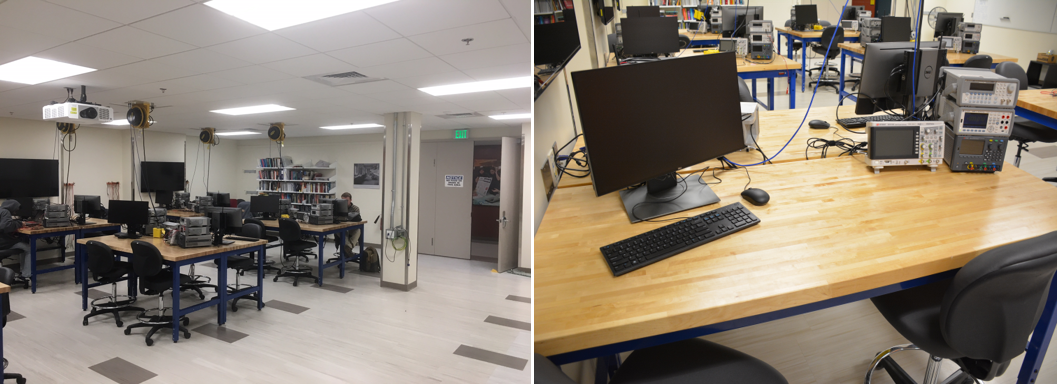
Votey 334 - 1100 sq. ft
Responsible faculty members: Jim Kay, Eva-Marie Cosoroaba
Courses that use the laboratory:
- EE 81 and EE 82 - Linear Circuits Laboratory I and II. The linear circuits lab courses are designed to complement the introductory circuit analysis courses (EE 3, EE 4).
- EE 183 and EE 184 - Electronics Laboratory I and II. The electronics lab sequence complements the junior year electronics courses (EE 120, EE 121) as well as the semiconductor physics and devices course (EE 163).
There are four fundamental aspects to these lab courses:
- understanding the theory of operation of practical devices and circuits;
- design and simulation of practical circuits and devices;
- characterization of devices, and construction and characterization (measurement) of circuits;
- analysis and documentation of results (including comparisons of measurements with theory and simulations).
During these courses students learn to identify particular devices, utilize data sheets, predict device and circuit operation, properly use equipment to provide power and signals as well as to make appropriate measurements, use computers to acquire and process data, and document lab procedures and results. Students are required to buy and use a kit of parts (including a protoboard for wiring circuits), a multimeter, and circuit simulation software. These items are used throughout the four-semester sequence. In the lab, students use a suite of Hewlett-Packard/Agilent/Keysight test equipment interfaced via IEEE-488 instrumentation bus (GPIB) to Windows 7 PCs. All PCs are connected to the college's high-speed network, and a network printer is available in the lab. PC software used for data collection and analysis includes Microsoft Excel and Microsoft Word (using Keysight Intuilink and/or Keysight BenchVue for data collection). In addition, a full version of Cadence/Orcad Capture/PSpice is available on the PCs for circuit simulation, and NI LabView is available for data acquisition on an as-needed basis. NI Multisim is also available for circuit simulation. MathWorks MATLAB is also available on the PCs for analysis.
KILBY - Digital Electronics Laboratory
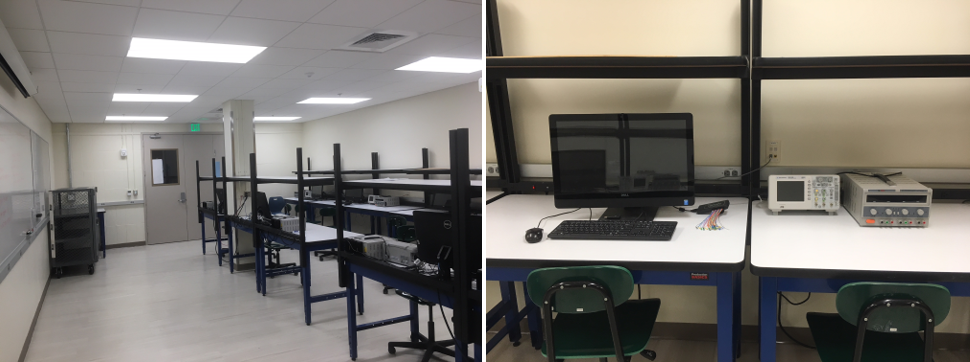
Votey 330 – 567 sq. ft.
Responsible faculty member: Tian Xia
Courses that use the laboratory:
- EE 134- Microcomputer Systems
- EE 231 - Computer Design
In EE 134, students learn the functional and technological characteristics of microprocessor structures, memory components, peripheral support devices, and interface logic. Through laboratory experiments and textbook examples the student will learn how to integrate and apply microcomputer subsystems and components to common interfacing problems. The Motorola 68HC12 microcontrollers serve as the vehicles for exploring these topics. In EE 231, students are instructed to learn reconfigurable computing both from a hardware and software perspective. The course covers basics of hardware description language (Verilog) and field-programmable gate arrays (FPGAs). Different laboratory projects are implemented including the development of a 16-bit microprocessor.
MARCONI - Communication Systems Laboratory
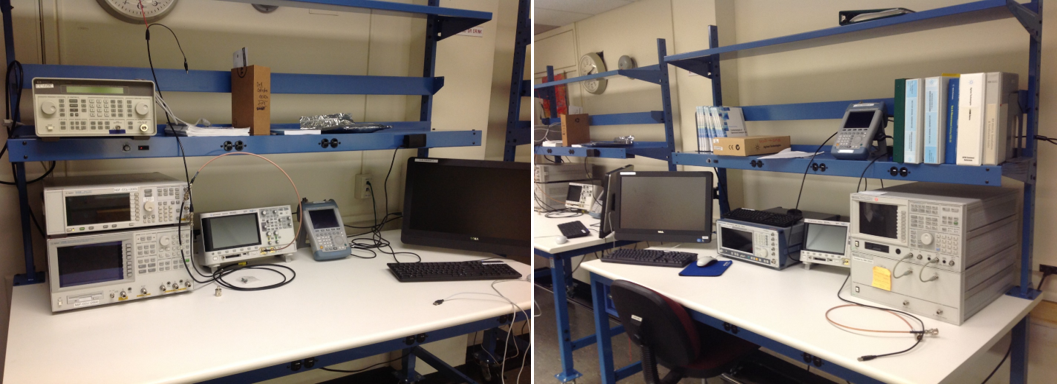
Votey 334B – 219 sq. ft.
Responsible faculty member: Jeff Frolik
Courses that use the laboratory:
- EE 174- Communication Systems
- EE 273 - Digital Communication Systems
- EE 278 - Wireless Communication Systems
In these courses students utilize the instrumentation for a variety of in-lab and field experiments. Students in EE 174 learn the fundamentals of spectral analysis using spectrum analyzers and oscilloscopes to investigate AM, FM and digital communication signals. Students in EE 273 utilize the vector signal analyzer to investigate digitally modulated signals (spectral analysis) and demodulated signals (through constellation diagrams). These signals are analyzed in the presence of channel noise and/or component distortion. In EE 278, students utilize portable signal generators, spectrum analyzers and network analyzers to conduct field measurements in various environments to characterize large- and small-scale propagation effects. The lab has two benches. One bench focuses on analog communications and device characterization. The other bench focuses on digital communications.
EBE Future Lab
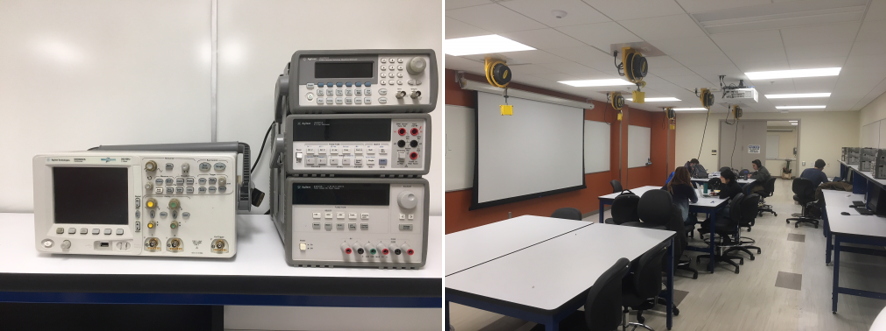
Votey 308 – 775 sq. ft.
Responsible faculty member: Hamid Ossareh
Courses that use the laboratory:
- EE 295 - Weable Sensing
- EE 210 - Control Systems Lab Section
General purpose engineering design space, used primarily by electrical and biomedical engineering students working on their senior design projects. It is also used by students who are taking courses or are members of clubs that have electronics fabrication needs. Students use this as a shared space to design, fabricate, and test ideas related to the various projects on which they are working. This laboratory space supplies students with the equipment and space needed to develop practical electronics fabrication and testing skills. The lab has plenty of open floor space, several large white boards and a projection system, making it ideal for students to work on larger projects. Students working on projects in this lab can access the full array of hand tools, hardware, handheld digital multimeters and soldering equipment, and electrical components for building and rapid prototyping. The lab also houses a Robotic Surgical Simulator (ROSS), which will be used for special topics courses and reverse engineering projects in the BME program.
TESLA - Energy Systems Laboratory
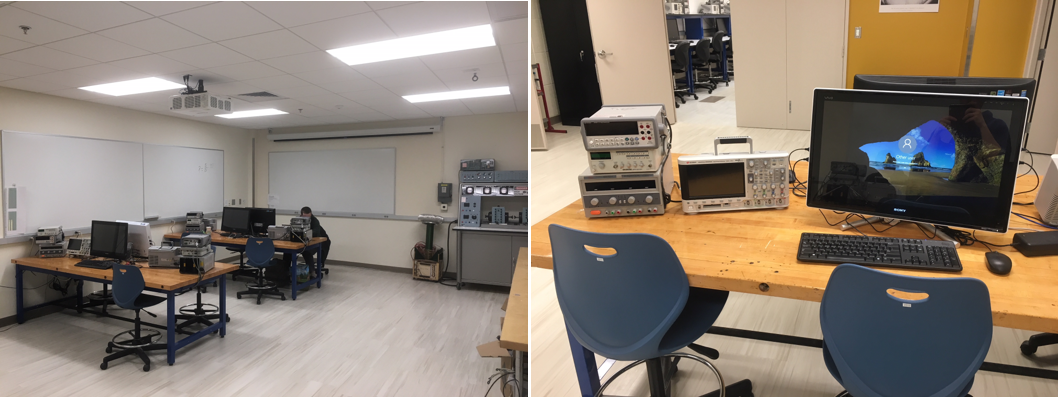
Votey 312 – 562 sq. ft.
Responsible faculty members: Mads Almassalkhi
Courses that use the laboratory:
- EE 113- Electrical Energy Systems
- EE 215- Electrical Energy Systems Analysis
During these courses students perform a number of experiments related to electricity generation and machinery, including experimental work with 3-phase power, transformers, motors, and generators. In EE 215, students are introduced to the theory and practice of power flow calculations, primarily using the PowerWorld software package.


